Route choices were decisive in this very interesting Sprint Relay in Doksy, Czech Republic – the second race of the World Orienteering Championships (WOC) 2021. In mostly flat terrain, which looked straightforward on paper, course setter Radek Novotny had made some very interesting challenges for the runners.
As reported in the “Maps & Results”-article for the race, Sweden’s athletes managed to solve the challenges in an excellent way, taking home the gold medals ahead of Norway and Switzerland. Here we take a more detailed look at the course and the most important decision points in the race – see the “Maps & Results”-article for full results and links to the full map and GPS-tracking.
Sorry for the delay: Note that Sprint Relays are the most tricky races to analyze – and split times were not available before upon request Monday morning. Therefore some delay before being ready to publish, but hope it is not too late to be interesting.
Overall race development
The below splits browser shows the overall race development throughout the course, with split times registered at all common controls. Decisive points are marked on the splits browser and will be discussed in the analysis section below. Overall, Sweden’s Tove Alexandersson had a 35 second lead halfway through the first leg, which Switzerland’s Simona Aebersold managed to cut down to less than 20 seconds at changeover. Switzerland’s Joey Hadorn started very fast and managed to catch Sweden’s Emil Svensk after a few minutes running.
Hadorn could not keep up with Svensk, though, and at the changeover the gap was nearly doubled to more than 30 seconds. Switzerland’s Martin Hubmann lost another 20 seconds to Sweden’s Gustav Bergman on the third leg, and thus Sweden’s Sara Hagström could take Sweden to a clear victory after starting with a nearly 60 second lead. Meanwhile Norway’s Kasper Fosser had run a very strong 3rd leg, bringing Norway into the battle for silver, less than 20 seconds behind Switzerland. On the last leg Norway’s Andrine Benjaminsen was faster than Switzerland’s Elena Roos, bringing the silver medals to Norway.
Note: Control 17P/18R for the women and 2oP/21R for the men and 15M/15L is marked as a common control in the split times although the runners have not been running the same distance, and thus runners have a +/- 10 seconds “bump” in the splits graph here even with good execution. This is indicated with a cross in the splitsbrowser to make clear that this is not due to mistakes.
Leg 1: Alexandersson takes Sweden to clear lead – but not without mistakes
The legs from control 5 to control 7 with a forked 6th control is one of the most decisive points on the courses – common for both men and women. On the splitsbrowser this section is marked with a blue (1), highlighting time losses of Switzerland (8 seconds) and Norway, Denmark, Great Britain, Czech Republic (15-21 seconds). The fastest route is different for the two variants: For variant E the fastest is to run to the right along the river (Sweden, dark green). The fastest route for variant F is to run to the far right (Poland, light green). Switzerland’s route (yellow) gives an 8-10 second timeloss while the red S-shaped variants (Norway, Denmark, Great Britain, Czech Republic) give a 12-18 second timeloss.
The next section with big time differences is the forked control 9 – marked with (2) on the splitsbrowser. Here Switzerland lose 25(!) seconds to Alexandersson by going around the football-field to the right (red) when taking the 9H-control. This large time loss is difficult to explain based on her route choice, as this route choice seems to be the fastest for the men. It may be faster to run left from the 9H-control to control 10 (Denmark does this, but still loses 22 seconds; Great Britain loses 20 seconds on Switzerland’s route). From the first leg only it may seem that the 9H-forking is 20+ seconds slower than the 9G-forking, but Norway’s Benjaminsen on the last leg runs the 9H-forking only 4 seconds slower than Alexandersson (and 21 seconds faster than Aebersold), so the reason for the big time losses on the first leg is not due to forking differences.
The next section with big time differences is the forked control 9 – marked with (3) on the splitsbrowser. Here Norway and Great Britain (15 seconds) and Czech Republic (10 seconds) lose significant time, while Aebersold catches up some seconds on Alexandersson. It is not clear from the GPS exactly why the time losses are so big here; for example Norway runs the same route as Sweden and still loses 12 seconds to Sweden.
The next section with significant time differences is control 17 – this is simply a mistake by Tove Alexandersson (marked with (4) on the splitsbrowser), costing her around 10 seconds (Benjaminsen runs another 4 seconds faster than Denmark’s Klysner; 12 seconds faster than Alexandersson).
Leg 1 summary: Switzerland loses around 30 seconds on route choices – more than they are behind Sweden – thus Aebersold would have had a great chance to be even with Alexandersson with a clean race. Norway, Great Britain, Denmark and Czech Republic also did significant route choice misses.
Leg 2: Sweden’s Svensk is caught, but runs away again
Sweden’s Emil Svensk loses 7 seconds to fast-starting Hadorn to the first few controls (not shown here), and then 13 additional seconds at the forking around the 4th control (shown below; marked with (5) on the splitsbrowser). Here Svensk (red route) does a route choice mistake in running around the first house to the left. In addition the Swede has the D-variant (along with Norway), which seems to be some seconds slower than the C-variant. But this means 13 seconds lost here and 7 seconds on the first control for Svensk. This means that Svensk is caught by Switzerland’s Joey Hadorn.
But here Hadorn’s luck (or mistake-free orienteering?) stops, and on the forked section from control 5 to control 7 the Swiss runner loses 10 seconds to Svensk (marked with (6) on the splitsbrowser) – and also the initiative in the race. If you look at the routes below closely, you see that Svensk has the F-forking and Hadorn the E-forking. When running this S-shape route (which you may remember from the women’s 1st leg is not the best route on this section), the E-forking is around 10 seconds slower than the F-forking. However, Kasper Fosser on the next leg runs the F-forking 14(!) seconds faster than Svensk by taking the optimal route choice to the right.
Note also that no runners on the 2nd leg run really good on this section, thus Svensk looks very strong with a time 5 seconds faster than all the others on this section.
Next up is the section from control 8 to 10 (marked with (7) on the splitsbrowser). Here Switzerland’s Hadorn makes an 18 second mistake (does not see the route choice to the right from 9G to 10) , and is suddenly nearly 30 seconds behind Svensk.
Hadorn is not the only one losing time here. Interestingly, Svensk runs the fastest split time on the same route as Aebersold run on the first leg here – a route where Aebersold lost 25 seconds on leg 1.
Leg 2 summary: Switzerland again loses around 30 seconds on route choices – more than they are behind Sweden – thus Hadorn would have had a great chance to be even with Svensk with a clean race. However, Svensk did also not do a clean race. Norway, Great Britain, Denmark and Czech Republic also did significant route choice misses. Note also how Norway loses 10 seconds by running wrong into the changeover chute.
Leg 3: Impressive catch-up by Norway’s Fosser
Norway’s Kasper Fosser ran an exceptionally good race on leg 3, 44 seconds faster than Emil Svensk and Gustav Bergman, 56 seconds faster than Joey Hadorn and 1:08 faster than Martin Hubmann. The second fastest man was Aleksi Niemi, 34 seconds behind Fosser. Part of this was higher running speed, but Fosser also had a very good technical race.
The biggest catch-up on Bergman and Hubmann was on the section between control 5 and control 7 (marked with (8) on the splitsbrowser). Here Fosser took the best routechoice to the right, whereas both Bergman (+27 seconds) and Hubmann (+16 seconds) went in the course setters trap and ran the S-shaped route. Part of this is due to higher running speed, but the time losses due to wrong routechoice is surely 10-20 seconds or more.
Several other runners also lost time her; Poland’s Pryjma catches the fastest route to the right and is only some seconds behind Fosser on the leg.
The next place where Fosser takes significant time on Hubmann is to control 19 (marked with (9) on the splitsbrowser). Here Hubmann loses 12 seconds to Fosser (red route below).
Leg 3 summary: Great catch-up by Fosser, taking Norway into the battle for silver. Switzerland’s Martin Hubmann has a bad day, loses 1:08 to Fosser, significant parts of this due to routechoice misses. Sweden’s Bergman loses more than 40 seconds to Fosser, but still runs a good race alone in front.
Leg 4: Decision time – safe run for Sweden, fast run for Norway
Sweden’s Hagström takes it easy out from the start, losing 14 seconds to Norway and 6 seconds to Switzerland (marked with (11) on the splitsbrowser). It does look like this mainly is due to execution, and not due to wrong routechoice.
Next up is the section from control 5 to 7 (marked with (12) on the splitsbrowser) where Sweden’s Hagström runs an excellent leg with the F-alternative, and beats Benjaminsen and Roos with 9 and 12 seconds, respectively. Czech Republic and Great Britain run the S-shaped direct route and lose nearly half a minute to Sweden here.
Next the section 8 to 10 (marked with (13) on the splitsbrowser). Not very big time differences here, but it is still included as this is decisive for the battle for silver. Norway beats Sweden with 6 seconds here.
Next up another time loess for Sara Hagström, this time 13 seconds to both Norway and Switzerland (marked with (14) on the splitsbrowser). Here both Sweden and Great Britain lose some time by running left (red lines) to variant J.
Next up control 14-16 (marked with (15) on the splitsbrowser). The time differences are relatively small, but the leg was still very decisive.
Leg 4 summary: Great catch-up by Benjaminsen, deciding it towards the very end. Hagström did not run a perfect race, but didn’t need to either…
 World of O News
World of O News
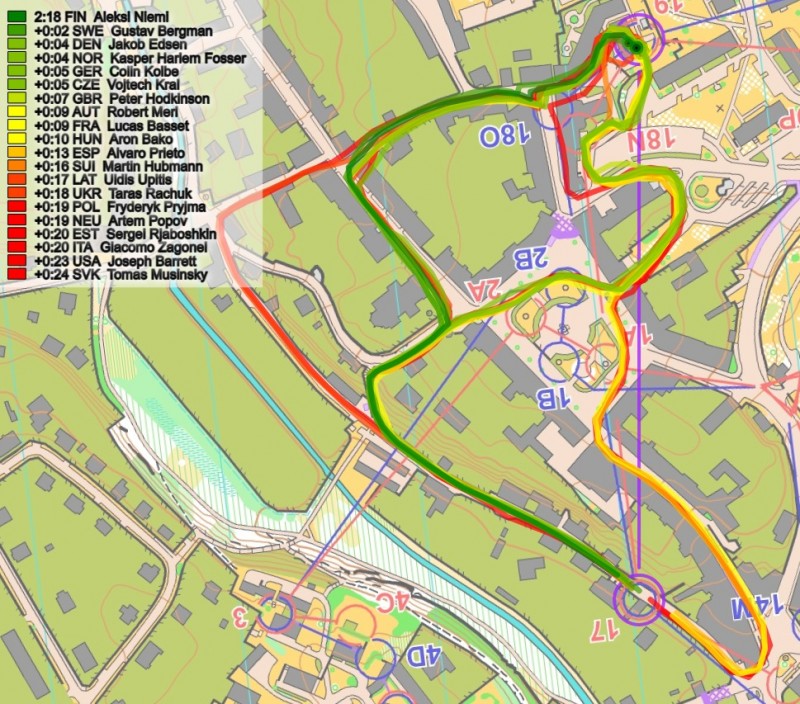
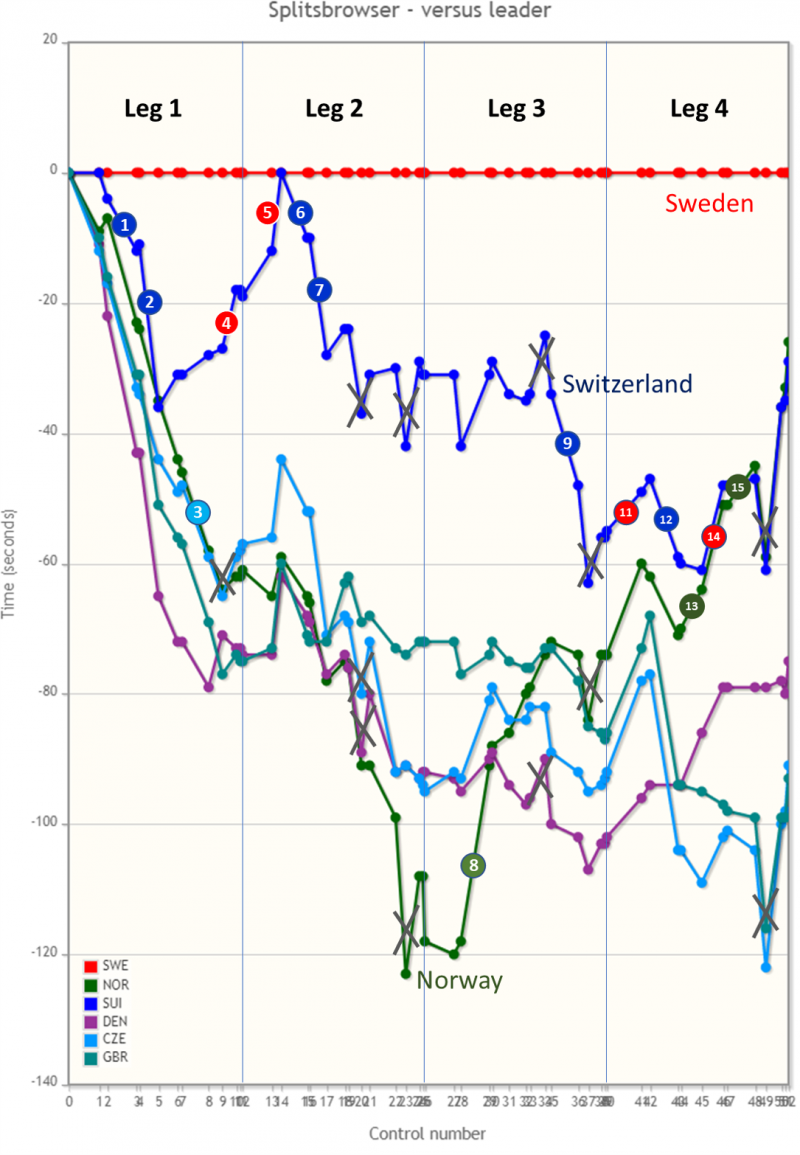
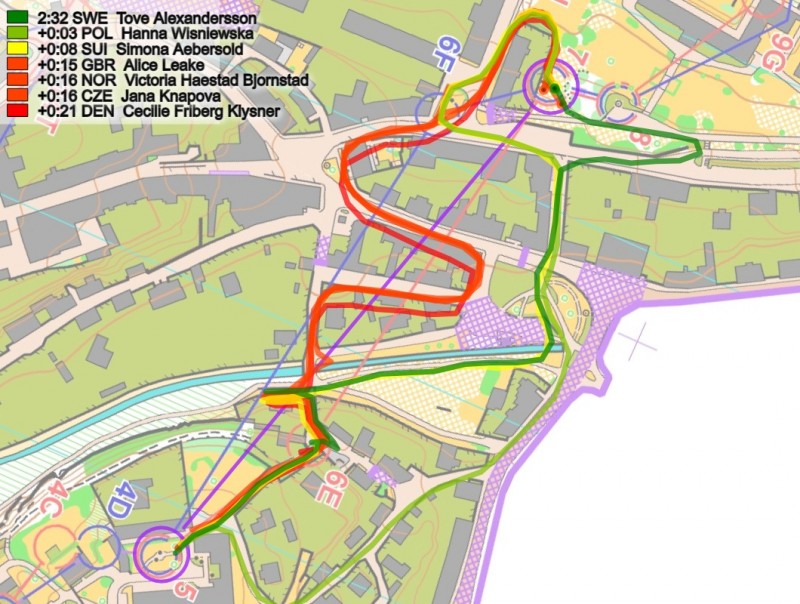
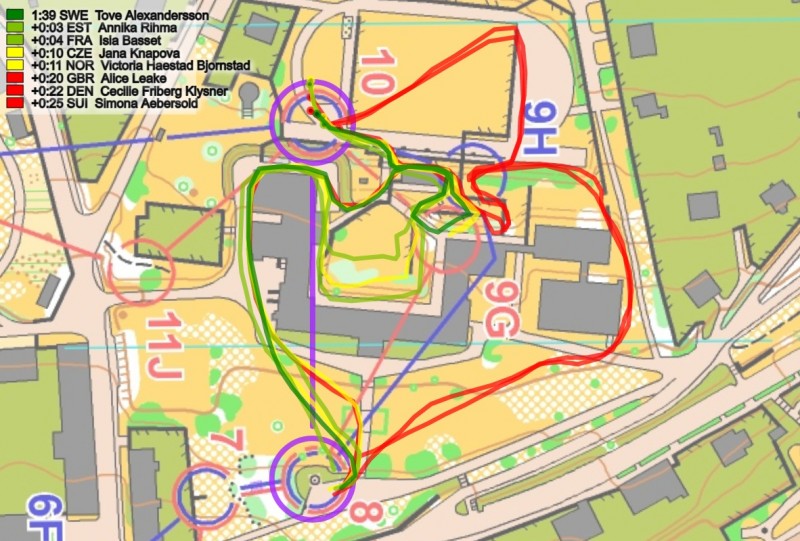
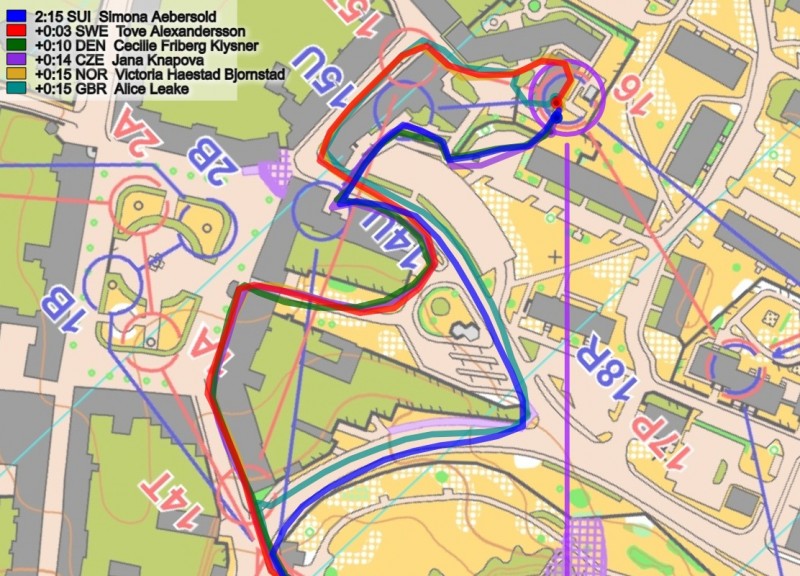
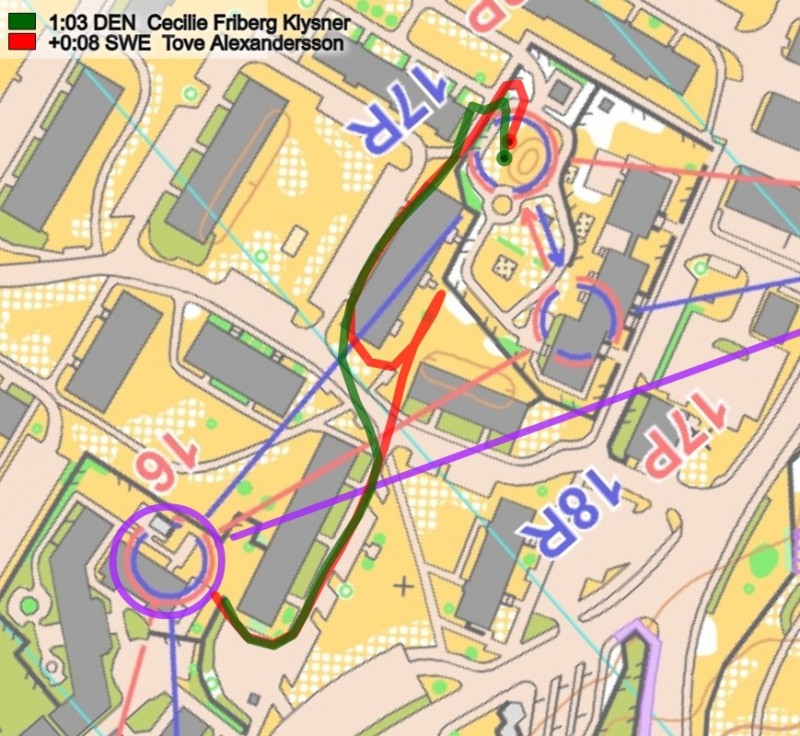
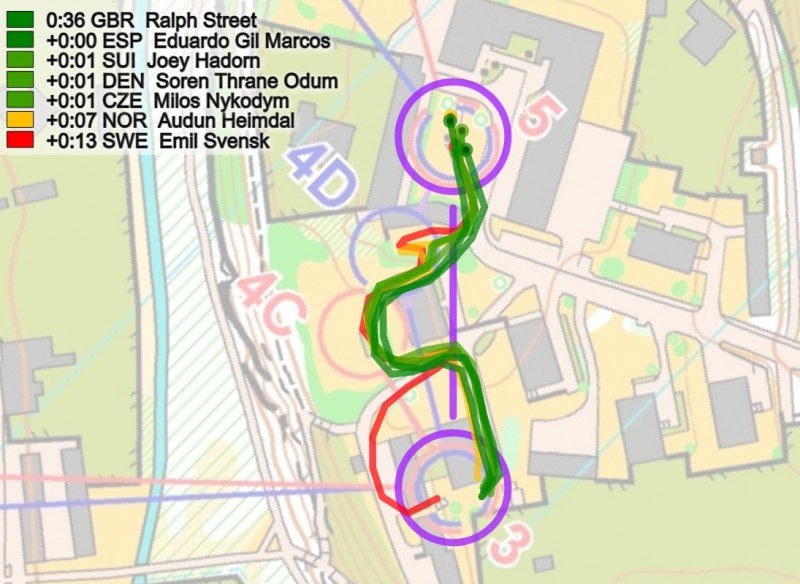
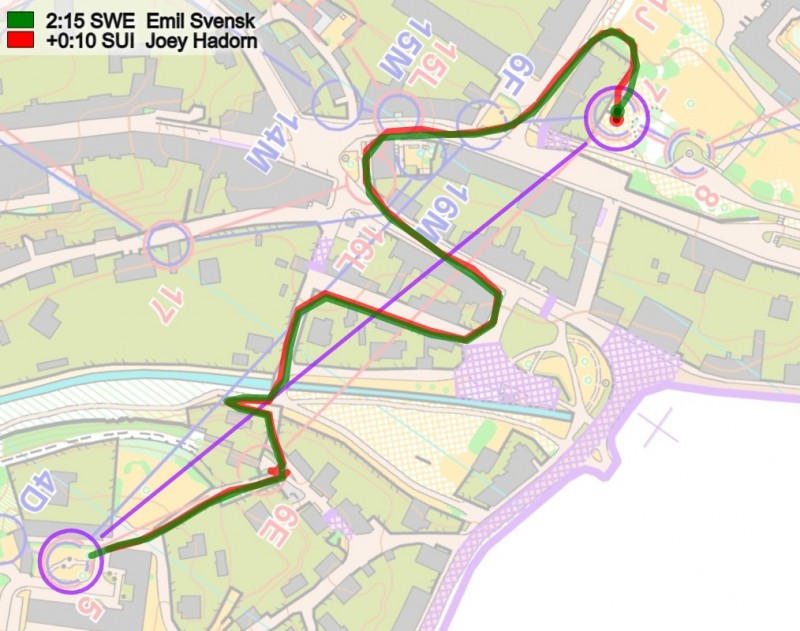
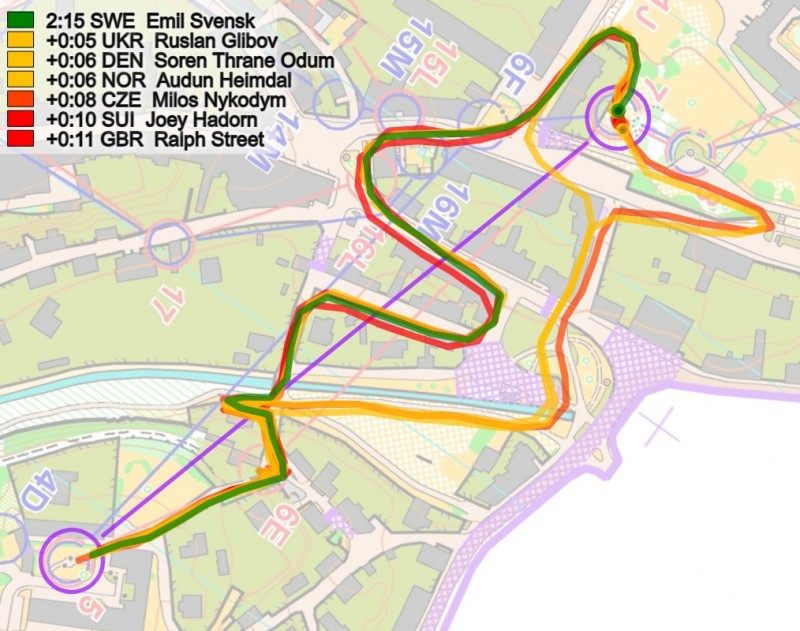
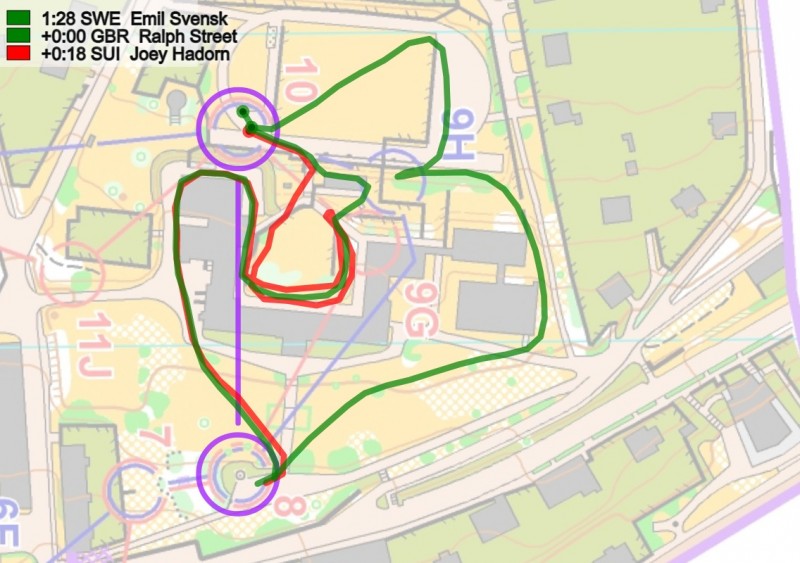
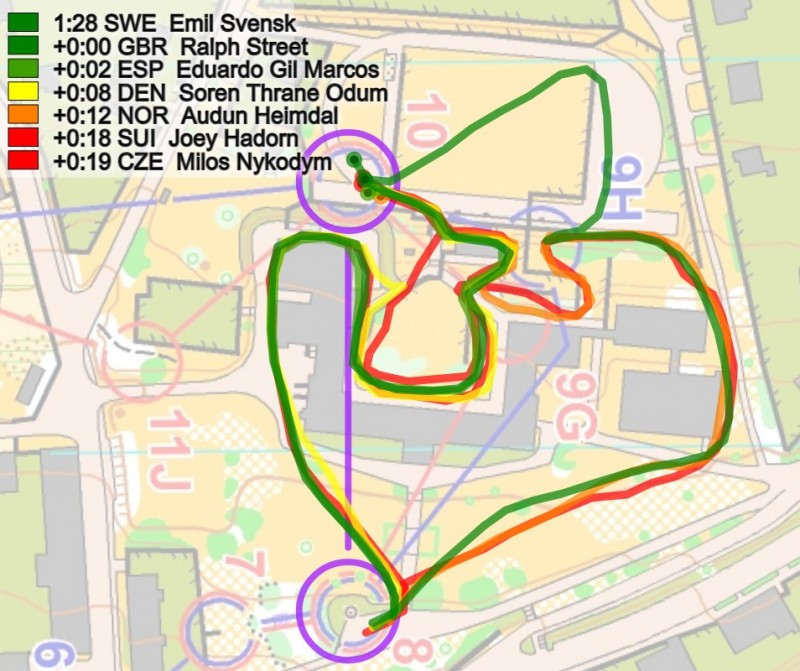
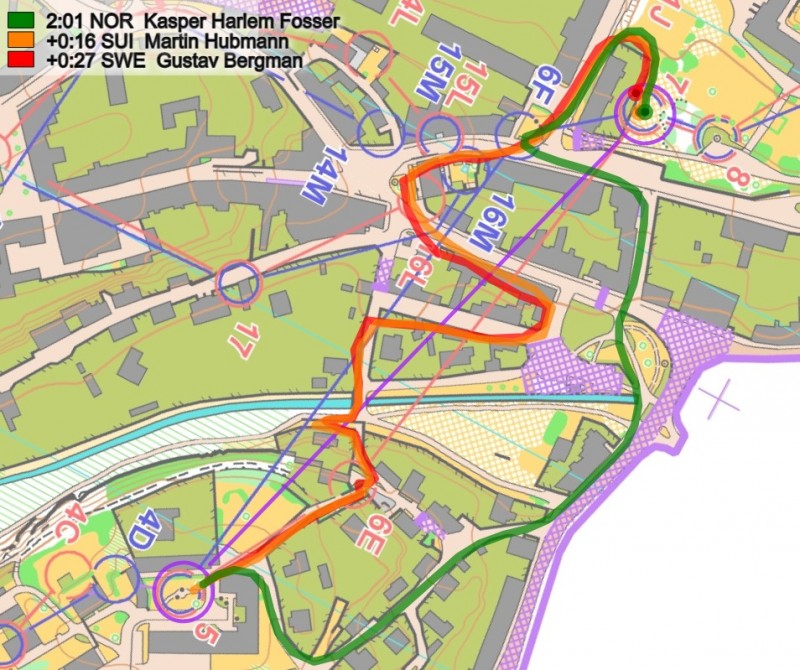
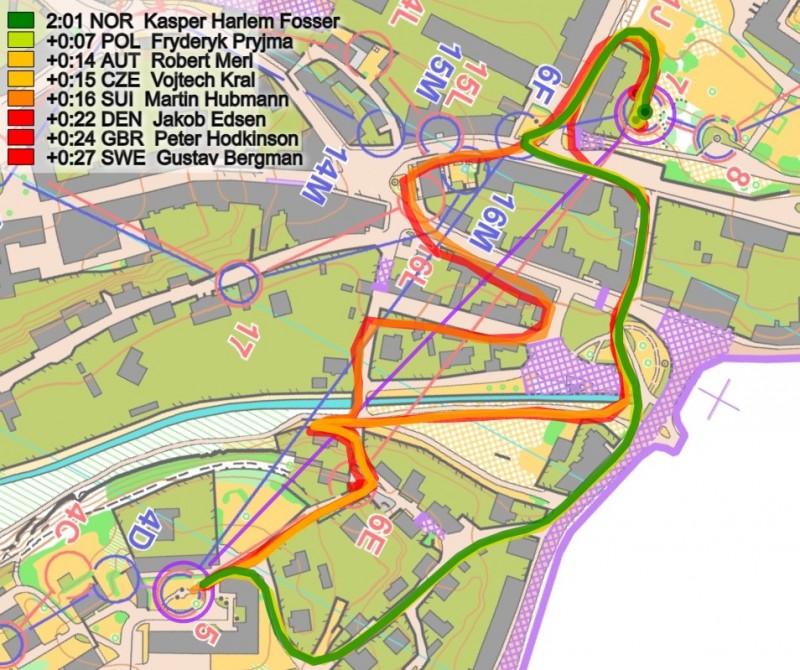
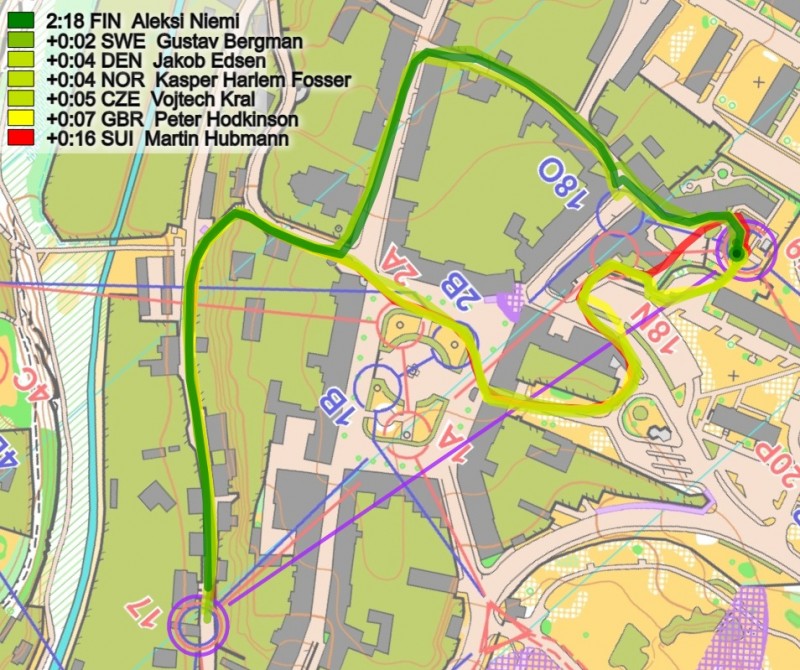
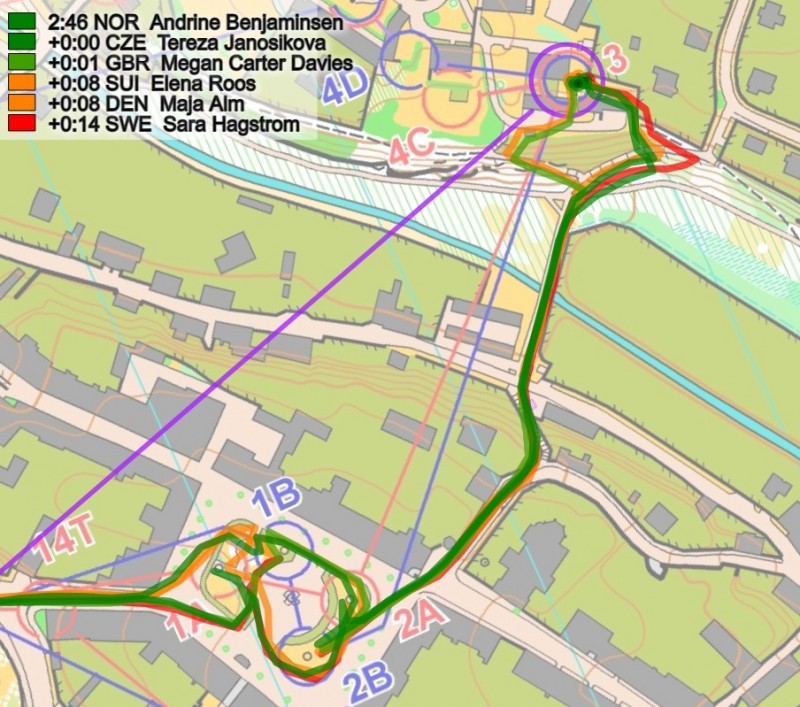
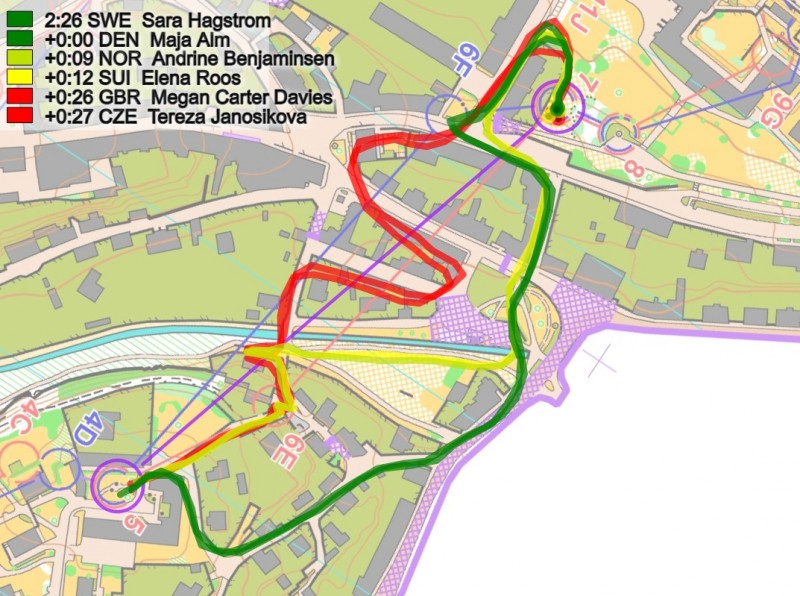
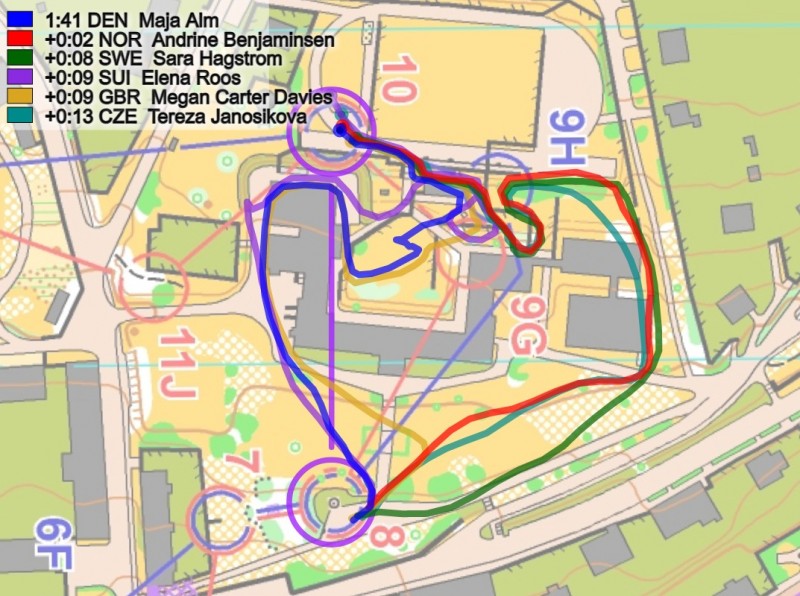
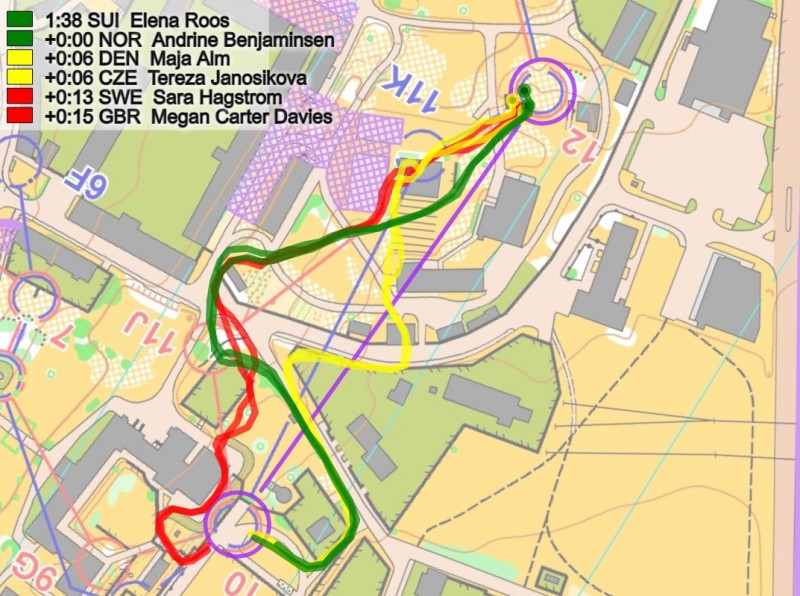
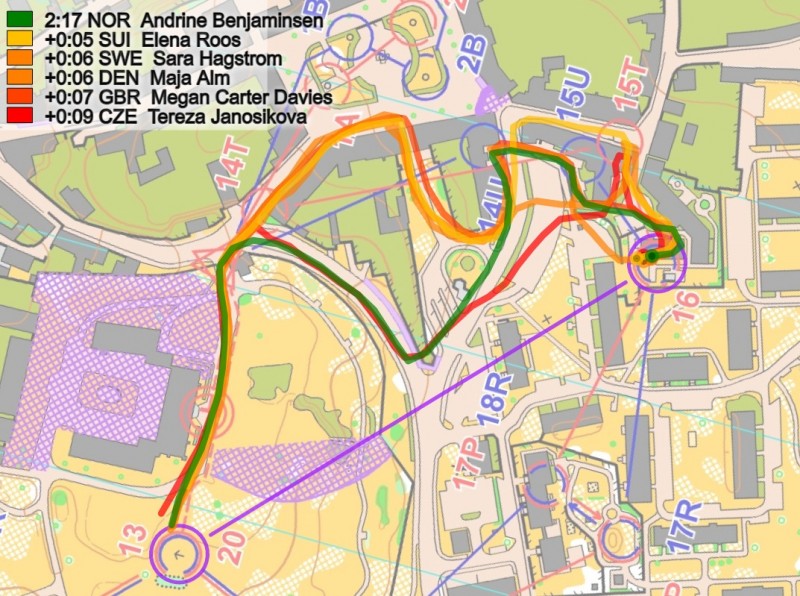
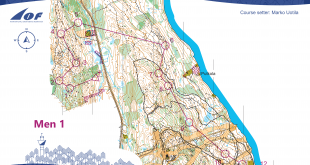
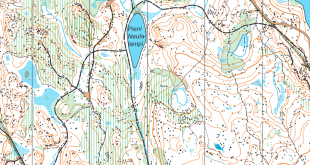
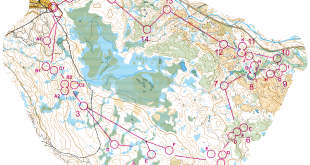
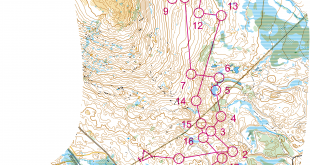
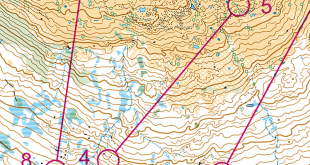
Great analysis, thanks. It is a pity that most of these exciting differences with time losses and gains could not be visualized and explained in the live TV-broadcast. The impression that Sweden was totally dominating the race, being far better than all other teams on running speed and had a close to perfect technical execution is just wrong. All teams, including the medalists had significant time-losses. The route-choice challenge and course setter trap from control 5 to 7 was quite good explained, but the the expected time losses could have been estimated in seconds by the course setter so that the commentators could simply state this. E.g., that KHF now would gain approx. 15 seconds on MH. The 8-10 leg mistakes, e.g. by JH, disappeared completely. Also a pity that the GPS-tracking on TV could not highlight the dramatic fact that TA ran into a dead end and had to turn back towards control 17R. Still the TV broadcast was a great step up compared to e.g. EOC sprint relay, with better GPS and better visualization of the technical route-choice challenges and differences. Final note, you have a small typo, talking twice about leg 9 in the leg 1 analysis.
Yes, this analysis shows this was great coarse setting by the czech arrangers. To the difference from EOC where the swiss team simply ran away from the others in a coarse without orienteering challenges, Sweden here had high speed but also made less mistakes in a very tricky competition.
Also a tribute to the finnishing half of the norwegian team who really showed their skills and how this should be done!
That is probably the biggest challenge in broadcasting sprint relay (and also sprint, but to a lesser extent). It is very difficult to figure out what has happened on the fly. Situations change, but nobody knows why, which is horrible from the viewers’ standpoint. To explain what has happened, one need split times and GPS and lots of time (like this article).
First thing to avoid would be setting up very small technical areas (like 8-10), where the GPS tracking turns into a giant mess. How to still make the forkings and courses in general tricky enough, I have no idea…